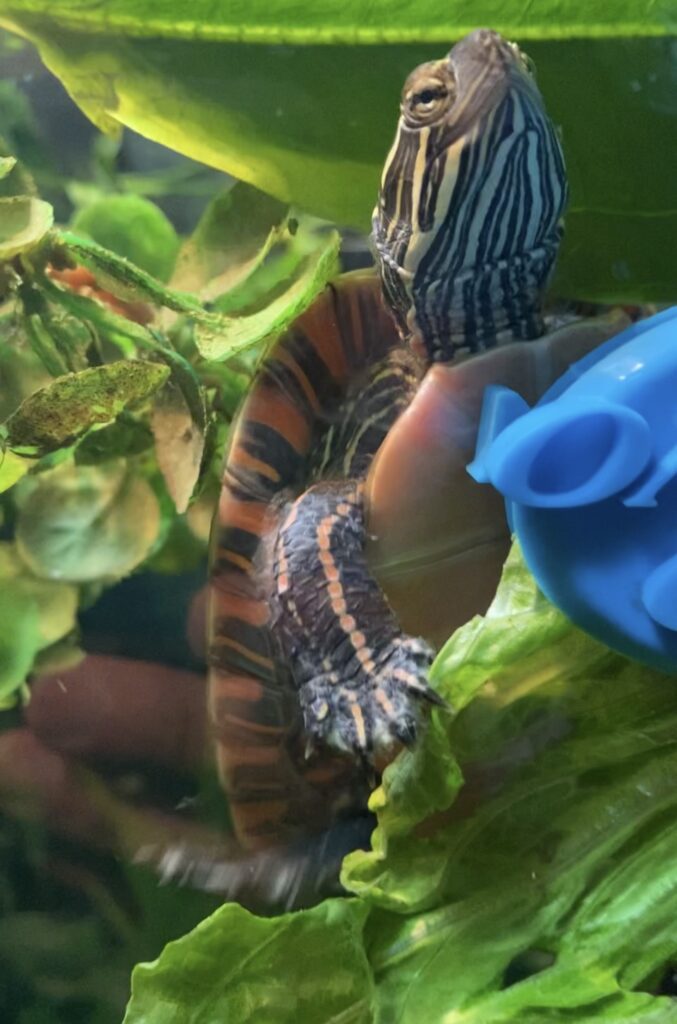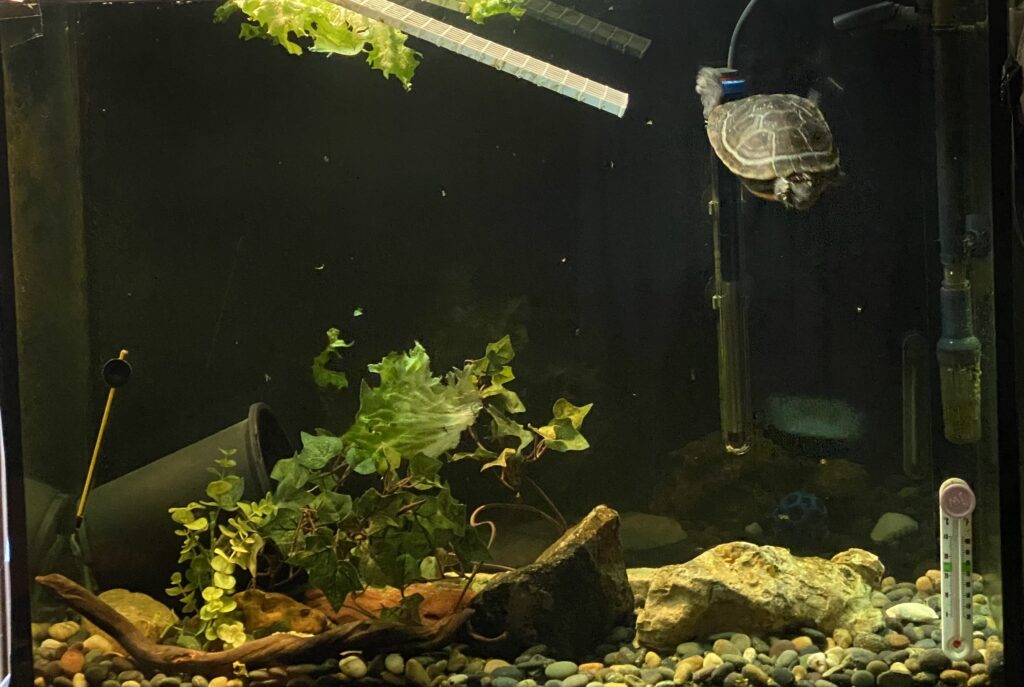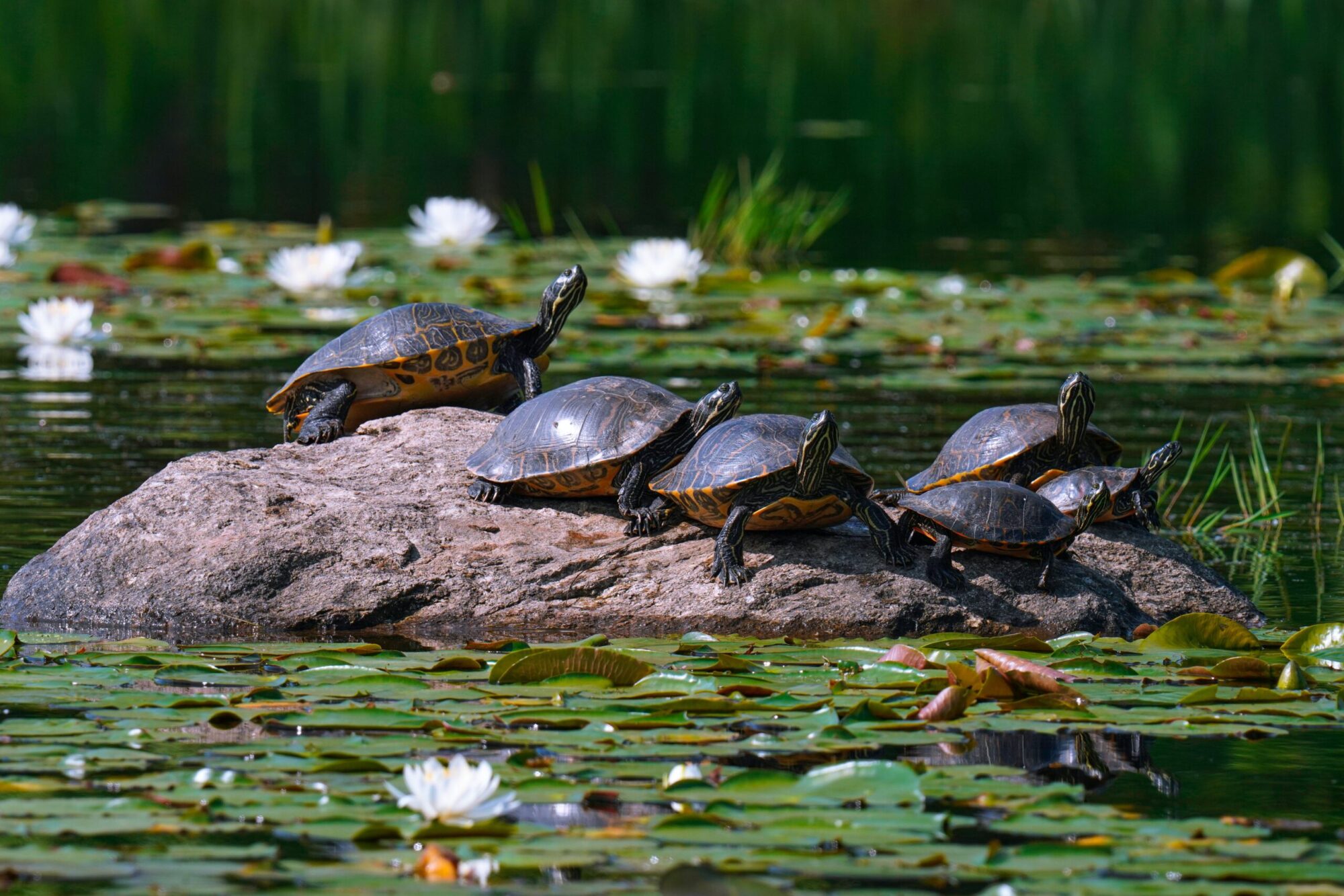When looking for a new pet, turtles may not be on your list. Should they be though? Let’s explore that question together.
I love turtles. They are amazing creatures, and I could watch them do their little turtle things all day long. So of course, my first response to this question is yes, turtles make great pets! The more turtles the better- turtles for everyone!
But I’ve owned a turtle, and so my answer necessarily includes a list of practical considerations.
Don’t get me wrong, I’m not saying, “Don’t get a turtle”. I’m saying, here are some real things to consider if you’re thinking about getting one. A lot of information on the internet leads you to believe that turtles are good beginner pets- which is not true!
The way I came to own a turtle, was that someone I knew was looking for a home for one that had been hurt and abandoned, and I jumped at the chance. ‘What great fun to learn about a new creature I’ve never had much experience with before’ I naively thought. Of course, we were going through a major move at the time, which was not conducive to the extensive research required to properly care for a new pet. It was a very stressful time- especially because caring for an aquatic turtle is very complicated. More so than I ever imagined! Of course, I loved (loved, loved, loved) having a turtle, and I’m grateful for the years that I had with her, but at the same time, it was so very difficult.
These are practical considerations that I wish I had known before bringing a turtle home, in the hope that I can spare someone else a few headaches.

Here are 9 things to consider before buying an aquatic turtle
Aquatic Turtles Are Aquatic Animals
Yes, I know that’s repetitive, but purposely so. I didn’t think that this was such a big deal at first. So what, they need a swimming pool? What’s the big deal?
But aquatic turtles don’t need a pool to dip their toesies in when they get too warm- the ‘pool’ is where they live. It is their home, and, as their home, it needs to be perfectly adapted for them.
How do you do that, you ask? In these ways:
Tank size– Turtles need big tanks, and keeping them in tanks that are too small is unnecessarily cruel. I hope that none of us want them to suffer. Since most aquatic turtles will grow to be about 8-12 inches, depending on the species, they need about 10 gallons of water per inch of shell length. This means a turtle with a 4” shell would need a tank that holds 40 gallons of water, and one with a 12” shell would need a 120-gallon tank. That’s a big tank with a lot of water!
Not only are big tanks expensive to buy, but what nobody talks about enough is: water is really heavy. One gallon of water equals 8.34 lbs. That may not sound like a lot until you realize that a tank with 40 gallons of water will weigh 334 lbs. A 100-gallon tank weighs about 834 lbs.
At some point, you have to ask yourself- how much weight can my tank cabinet hold, and, for that matter, how much can the floor itself hold? As my turtle grew, I was doing calculations on pressure per square inch, going into the basement to check out load-bearing walls, and observing the position of the floor joists, all to try to not break our house.
When you have that much water in a tank, there’s all the added humidity. Too much can do permanent damage to walls and window frames. While my plants and I liked the additional moisture, our books weren’t big fans. If we would have kept the turtle, we would have had to come up with a solution.
Temperature– Unlike us, turtles cannot regulate their body temperature by themselves. They rely on external heat sources. Their water temperatures must be between 72-80 degrees, depending on the type of aquatic turtle, or else they can get sick, and possibly die. In most houses, this requires a heater or two, depending on the size of your tank. Any time you combine water and electricity, extra precautions need to be considered, since water and electricity do not mix well. Thermometers in the different parts of the tank to monitor temperatures become essential, though they are fairly inexpensive.
Water Condition– Water condition is very important to turtle care, as it is where they spend most of their time. But you can’t just fill up the tank from your faucet and call it good. Depending on your water source, it may contain chlorine and chloramine which may harm your turtle. Also, if your water is too “clean” it can harm your turtle. You want to have some beneficial bacteria in the tank to absorb the ammonia and nitrates that turtles produce in their waste, through a process of tank cycling. Testing for nitrates, ammonia levels, and pH becomes routine, and these test kits cost money. And on top of that, you need a powerful tank filter- way bigger than for fish- to filter out waste, but not the beneficial bacteria that are working in the tank. Filters are expensive, loud, and depending on the model, can use a lot of electricity.
Got all that? Moving on.

Turtles Also Need “Land”
Even though turtles spend the majority of their time in the water, they need to come out of it for 8-10 hours each day and bask under artificial light. These lights help them regulate their body temperature, absorb essential nutrients, along with UVA and UVB rays, and dry out so they don’t grow fungus. These special lights are expensive and can use a considerable amount of electricity.
And to bask, turtles need a basking platform, one that is suspended out of the water for them to climb up onto, and dry out. To achieve this in a water tank is more difficult than you might think. It requires some creative thinking and engineering to create a platform, and a ramp at a comfortable angle for climbing. The platform needs to be a certain distance away from the light so the temperature is in a comfortable range: 85-95 degrees, depending on your turtle. Temps can quickly become too hot or too cold.
Also, the platform needs to be protected so the turtles don’t fall off the edge. And you know what animals are intrigued by basking turtles? Cats and dogs. Your turtle needs protection from curious animals (or kids!).
Also, some female turtles may need access to a place with dirt or sand to lay eggs. So there’s that.
Your Turtle Needs a Certain Air Temperature
Before having a turtle, I never thought about the temperature of our air that much. I knew when I was comfortable, and when I wasn’t, but that’s about it. With a turtle, I had to monitor the air temp at all times- day and night. If your air temperature is too warm or too cold, your turtle might not come out and bask, which could make them get sick and die. Air temps need to stay between 75-85 degrees, which is difficult to keep consistent in a home environment.
Turtles Need a Healthy Diet
Finding food that my turtle liked was a lot of fun. Turtles need a variety of foods: proteins, fruit, and vegetables. Finding healthy foods for my turtle to eat was something that I looked forward to each day, and made me very excited. I would even collect grubs, slugs, and bugs outside as a treat. Turtle food isn’t that expensive, but some turtles can be extremely picky eaters.
In addition to good food and a variety of fruits/veggies, turtles need supplemental calcium, usually in the form of cuttlebone. It’s fairly easy to find, locally or online, though there are occasional shortages. However, cuttlebone has a hard coating on one side which needs to be painstakingly scraped off with a knife. Alternatively, there are calcium powders available, but the hard cuttlebone helps keep their beaks trimmed.
Turtles Need Enrichments
A simple tank full of water and a basking area make a bored, unhappy turtle. Just like all other creatures, they need enrichment to engage the skills they would be using in the wild. All tanks, no matter the size, need places to hide, and things to explore, like wood, plants (artificial or real), and toys. Large gravel is appreciated by some, and a sandy bottom to dig in is needed by others. Making an engaging and beautiful tank for both you and your turtle can be quite a bit of work, but also an extremely fun activity. It’s difficult not to keep improving it!
And last, but not least,
Turtles Are Considered Exotic Animals
As such, not a lot of vets or pet stores know how to care for them. Finding a vet that cares for exotic animals usually requires traveling and paying a bit more for services. If you think that you can just google the information, think again. A lot of the information on the internet is not helpful or is completely wrong. Turtle care requires an extensive amount of research and some trial and error to figure out how to give them the best life we can.
Also, as exotic and not domesticated animals, turtles don’t always enjoy companionship with us the way a dog or a cat would. They are, on the whole, shyer and solitary by nature. Of course, turtles all have their own personality, and they do vary individually. Respecting your turtle’s preferences is key.
Ok, so those were cautionary considerations. In addition to all that, here are some reasons why turtles make awesome pets!

They’re Fun to Watch
People usually think that turtles are green. They are, but there are so many other colors also. Subtle mixes of greens, blacks, reds, and yellows make up most aquatic turtle bodies in an artful fashion. Some have spots, some have stripes, some are darker, and some are brighter. They are all beautifully made.
There is something enjoyably hypnotic about watching them swim around in their tank. Beautiful swimmers, they are curious about everything that they see and smell. And when they are basking, extending their arms and legs out in front of them, they are the epitome of goofy and graceful. Once you begin to observe them, you’ll want to watch them for hours.
They Will Interact with You
Most turtles like some attention, as long as you take their personalities into account. They especially like food! Notorious beggars, most turtles are very excited to see you in the hopes that you’ll give them something good to eat. They’ll swim excitedly up to the top of the tank, and most can be trained to take food out of your hand.
There are So Many Related Things to Learn
Once you get into turtle care, you can branch out in so many different directions. I tried my hand at growing aquatic plants, and enjoyed seeing the beautiful creations of those skilled in the field, along with hobbies like aquascaping, vivariums, terrariums, and paludariums. The environments that people create with supplies collected from the woods or purchased online, combined with rocks, gravel, and even waterfalls are quite amazing. In addition, learning about the different creatures that can live in those different environments is fascinating.
Also, I found the process of water filtering quite interesting. I did a lot of research on how to make a homemade filter, and dived into different kinds of filter media. And this ties in with my love of gardening. I flittered into learning about different areas of sustainable practices like desert greening or different kinds of regenerative gardening, and aquaponics. All of it ties in nicely with my interest in native plants, which I wrote about here.
So there you have an answer as completely as I can give it. Do you think we answered the question?
Yes, turtles make great pets for so many reasons, but they aren’t easy, inexpensive, or for beginners or unsupervised children.
Sharing your home with one of God’s creatures is always a gift, and I, for one, want to give them the best life that I can. I hope this article helps you. Leave your thoughts and comments below! I’d love to continue the conversation.

